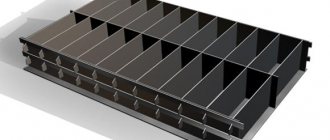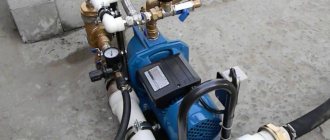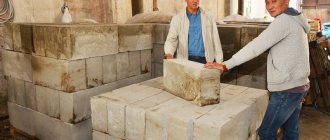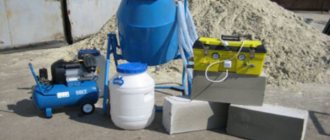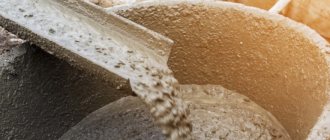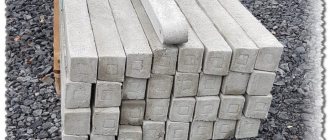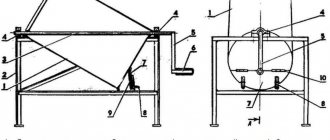What is this solution?
Foam blocks are made from a material that has a cellular porous structure, which is obtained due to air bubbles filling the solution. Stable foam is mixed with a cement-sand mixture, poured into a mold and hardens.
As a result of mixing, a material is obtained that has some advantages:
- increased thermal insulation properties;
- reduced cement consumption;
- less weight and savings on foundation, masonry, transportation;
- simple and easy processing;
- strength gained over time;
- environmental friendliness.
The foaming agent itself can be purchased ready-made or concentrated in different packaging - barrel, can, canister. In addition, to save production costs, it is possible to make it yourself.
The composition has a homogeneous structure and differs in properties depending on the composition of the components.
The term foam concrete
Foam concrete is a material that has recently begun to be intensively used. It became widespread in the 2000s and 90s of the last century, although it was known earlier.
This material is widely used today, it is relatively cheap and has excellent thermal insulation properties with a small weight of products and structures made from it.
Foam concrete structure
First, let's define the terms:
- It is customary to distinguish between foam concrete and foam silicate. These are similar, but completely different materials. By definition, concrete is a mixture of aggregate and binder, so both materials qualify under this name. But it is generally accepted that only cement-based mixtures that can harden under normal conditions are considered foam concrete.
- Foam silicate is produced on the basis of lime and sand, and requires autoclaving to acquire the necessary characteristics of a building material. Although, to be fair, we note that the composition of foam concrete blocks to accelerate hardening in industry is often treated with steam under high pressure, and lime mixtures without steaming can achieve the required strength and water resistance after several decades.
- You also need to distinguish between foam and aerated concrete. In the latter, the porous structure is formed due to the chemical reaction of the components of the mixture; the air cavities are open and smaller in size.
Note! There are combined materials - foamed aerated concrete. They use both methods to form pores. By foam concrete, we mean cellular lightweight concrete made from a cement binder. Most of the volume of such concrete is occupied by closed pores (this is clearly visible in the photo above), due to which the low thermal conductivity of the material is achieved.
Unlike porous silicate products, foam concrete does not collapse under high humidity - but, on the contrary, gains additional strength over the years. Unlike aerated concrete, due to its closed pores it is more frost-resistant, as it absorbs less water.
Characteristics
Concrete foaming agent can be organic or synthetic. Synthetics, compared to natural products, have a lower price and are used for the production of low-quality products.
When using chemistry, the block production time increases. The strength of foam concrete will be lower. An attempt to improve quality will lead to an increase in production costs and a decrease in its profitability.
Some plasticizers react with synthetics and therefore the choice of components is limited.
Retail chains in Moscow and other big cities offer a wide selection of domestic and imported synthetic materials. For remote areas, purchases can be made through online stores.
The price per kg of foam former varies from 70 rubles. and higher. You can use synthetics both in schemes based on barotechnology and in classic versions with a foam generator:
- Barotechnology is a less expensive and simple process. The basic components of artificial stone - water, cement, sand or ash - are introduced into a sealed mixer along with a foaming agent. The pressure in the mixing container is then increased, at which the composition is mixed. During the stirring process, the solution becomes saturated with air. To accelerate and regulate structure formation, it is possible to use functional additives.
- A foam generator is needed to produce foam separately. It is a container into which the foam former is poured. The composition from it is fed into the mixing chamber, where it is combined with air from a pump or compressor. The emulsion flows through a jet or Laval nozzle into a foam cartridge designed to foam the starting material. The output is foam, the quality of which changes due to the adjustment of the valves for supplying the foaming emulsion and air. They are placed in front of the mixing chamber together with shut-off valves.
Organic foaming agents (protein or protein)
They are considered to be higher quality supplements. When using them, concrete is obtained that fully complies with GOST 25485 - 89.
Organics have a number of advantages:
- Artificial stone cooks faster.
- After filling the form, the concrete mass is more stable.
- The composition of the blocks is more natural.
- High density concrete can be made.
Natural educators are a better choice, but are more expensive. Therefore, many manufacturers of building materials prefer to independently manufacture the composition and foam-producing units - foam generators.
The industry produces different types of organic educational foam.
For example, the protein composition “Etalon” is a dark brown liquid with a density at 20°C of 1110 kg/m3. The composition hardens at -250°C, has a pH value of about 7, and does not change its properties when defrosted. It can be stored at a temperature of - 50°C...+ 40°C in its original packaging for 24 months in a place out of direct sunlight.
The technical foam that will be obtained using the “Etalon” will have the following characteristics:
- foaming agents are diluted from 1:60 to 1:40 depending on the desired concentration of the working solution;
- water is used as a solvent;
- foam with a uniform microporous structure is white;
- multiplicity - 7-50;
- from 1 kg of foam formation, 830 liters of foam are obtained with a resistance of at least 98%.
Foaming agents: application features
Back in the 19th century, builders mixed bovine blood into the solution to create a cellular structure of concrete. At the beginning of the 20th century, soap root began to be used for these purposes. Now you can purchase a ready-made foaming agent for foam concrete. Its price will depend on the manufacturer, country of manufacture and type of active component. Domestic concentrate can be bought from 70 (“Neoplast-5”) to 100 rubles per kilogram (“PB-Lux”). Foreign protein formulations will cost on average 1.5 times more. For example, GreenFroth packaged in 230 kg (metal barrel) costs 125 rubles, and the cost of a canister (10 l) will be 185 rubles per kilogram.
Such formulations are usually produced as ready-to-use commercial products. According to the recipe, they only need to be diluted with water. Next, the solution is fed into the foam generator, where it passes through a special filler. Under the influence of a pressurized air flow, a stable foam is formed, consisting of a large number of small bubbles.
Another option for using a foaming agent is to add the concentrate directly to the water while mixing at high speed. Turbulence causes foam to form. Then cement and sand are added to this mixture with constant stirring. The quality of such foam concrete is slightly lower than that prepared according to the classical scheme.
Composition and varieties
To make a foaming agent for foam concrete with your own hands, you need to have an idea about its composition.
To obtain a foamed structure, surfactants (surfactants) must be added to the water. The simplest and most accessible surfactant is soap. The main problem with using soap compounds is that cement contains a lot of calcium.
If you add solid sodium or liquid potassium soaps, which are obtained by reacting alkali with animal or vegetable fats, sodium and potassium ions will be replaced by calcium ions. This will cause the resulting foam to quickly collapse, because... will not dissolve in water.
Therefore, foam for foam concrete is prepared from compositions in which acids, naphthenic or resin, are used instead of vegetable and animal fats. Such soaps in a calcium environment do not lose their foaming properties, but, on the contrary, increase them.
A complete list of foaming agents for foam concrete.
Foaming agent for foam concrete - made in Russia.
1.Pioner-Baro Kursk 2.Pioner-Bio Kursk 3.Pioner-Turbo Kursk 4.Pioner-Gips Kursk 5.Foaming agents SPO Shebekino 6.PB 2010 Tula 7.Arecom-4 Peter 8.Biofoam Lyubertsy 9.Belpor-10M OMSK 10.Benotekh PBS Novosibirsk 11.Betopen Moscow 12.Biolas-2 Omsk 13.Biopor Chelyabinsk 14.Maxpen Volgodonsk 15.Mikropor Izhevsk 16.NEOPLAST Omsk 17.OMPOR Omsk 18.PB-2000 Ivanovo 19.PB-2007 Mos kva 20.PB 2010 Tula 21.PB-Lux Voskresensk 22.PB-Lux Super Roshal Moscow region 23.PB-S Moscow etc. 24.PB-FORMULA 2012 Moscow 25.Penostrom Shebekino 26.PB 1 Novocherkassk 27.Protein Chelyabinsk 28.RELAN protein Tula 29.TSV Chelyabinsk 30.Foaming agent Ural 31.Ekopen Chelyabinsk 32.Elast Stary Oskol 32.EST Stary Oskol 33.Biotech Bryansk 34.Biofoam-Sinta Kursk 35.Biofoam Kursk 36.Pentasurfactant 430 grade A 37.Air-entraining additive START 38 . Air-entraining additive Rosin soap Kursk 39. Air-entraining additive Brand SDO-L® (PN) N. Novgorod 40. Air-entraining additive Brand SDO-L® (PSB) N. Novgorod 41. Air-entraining additive Brand SDO-L® (TP) N. Novgorod 42. Air-entraining additive Brand SDO N. Novgorod 43. Foaming agents “Rospena”. Moscow.
Foaming agent for foam concrete - made in Ukraine
1.ARSIKOL Ukraine Odessa 2.Eco-Por Ukraine Kharkov 3.Livoton Ukraine Lugansk 4.Aspent Ukaina Dnepropetrovsk 5.NIOPEN Ukraine Kiev 6.PENOFORS Ukraine Kiev 7.PO-HTUSA-01 Ukraine Kharkov 8.Sofir PB Ukraine Kharkov 9.Forward Ukraine Odessa 10.HTS 5 Ukraine Zaporozhye 11.UNISELL Ukraine Lisichansk
Foaming agent for foam concrete - made in Italy
1.Foamcem Italy 2.FOAMIN C Italy 3.GreenFroth Italy
Foaming agent for foam concrete - made in Austria
1.STEINBERG Zelle-1
Foaming agent for foam concrete - made in Germany
1.ADDIMENT SB 31 L 2.Reniment SB31L 3.Hostapur OSB 4.Centripor SK 120 5.LithoFoam
Foaming agent for foam concrete - produced in Kazakhstan
1.Unipor
Foaming agent for foam concrete - produced in Azerbaijan
1. TEAS - PB
Foaming agent for foam concrete - made in China
1.VEISICANT. Supplier Vladivostok
Foaming agent for foam concrete - made in Switzerland. Sika (Germany)
1. Air-entraining additive Sika LPS-A 2. Air-entraining additive Sika Aer 3. Air-entraining additive Sika Addiment LPSV C 4. Air-entraining additive Sika LPS-A 5. Air-entraining additive Sika Lightcreat
Foaming agent for foam concrete - synthetic Russia
“PB-2000”, “PB-2000-U”, “PB-Lux”, “PB-Lux Super”, “Arecom-4”, “Penostrom”, “Pentapav 430 A”, “TEAS-PB”, “ Stroybat", "Pioneer-PG", "Pioneer-Extra", "Pioneer-Tubro", "SDO", "SDO-L® (PN)", "SDO-L® (PSB)".
Foaming agent for foam concrete - imported protein brands
"Foamin C" (Italy); "GreenFroth-P" (Italy); "Foacem" (Italy); "Reniment" (Germany); "Addition SB-31" (Germany); "NEOPOR" (Germany); "E.S.T." (Russia); "Pioneer-Bio S" (Russia); "Elast" (Russia); "Biopor" (Russia); "Relan" (Russia).
Synthetic foaming agents for foam concrete are used for pressure installations.
(Or turbulent type installations).
WHAT IS FOAM FOR FOAM CONCRETE?
Foam is one of the types of dispersions.
Key foam indicators:
— multiplicity — dispersion — stability over time. — the ability to retain solid particles in the mass for a long time. The smaller the sediment of the foam concrete mixture, the better the quality of the foaming agent and the technical foam prepared on its basis.
All the basic properties of foam depend primarily on what foam generators or porosizers are used to produce it and the dosage of the foaming agent.
The stability (persistence or persistence) of foam in a mixture over time. And as a result, the stability of the porous mixture over time.
Characterized by sedimentation of the foam concrete mixture. If the structural strength of the interpore walls is insufficient (the result of the action of surfactants), they break through and merge.
Such changes in the porous mixture over time are measured by the height of the sediment of the porous mixture to its initial height.
Options. — Foam density is the ratio of liquid and gas phases. — Structural and mechanical properties — the ability to maintain its original shape for a certain time. - Load-bearing capacity - the ability of foam bubbles to hold a certain amount of other substances (solution) on their surface without destruction. — Dispersity is a value characterizing the average size of bubbles and their distribution over the volume of foam.
The main criteria for assessing the properties of foaming agents: - concentration of the foaming agent for the preparation of stable (resistant) foam; — multiplicity of foam produced; — coefficient of foam resistance in a binder solution.
The amount of foam, in turn, determines the cost of foam concrete!!! Ordinary foam concrete contains 400-500 liters of foam per cubic meter (with a density of 900-1400 kg/cubic meter).
More often than others, they use the “foam ratio” characteristic. For example, when evaluating synthetic detergents, although no clear connection was found between the foaming ability and the cleaning effect of powders and liquids.
Foam ratio. The foam expansion ratio is characterized by a value equal to the ratio of the volume of foam to the volume of solution contained in the foam.
Thus, this characteristic shows how many volumes of foam can be obtained from one volume of liquid.
High-quality foam for foam concrete can be obtained using our foam generators
- Foam generator type “PG - 120”
- Foam generator type “PG - 250”
- Foam concrete porosizer Determination of expansion and stability of low and medium expansion foam is carried out in accordance with GOST R 50588-93. Clause 5.2
Depending on the expansion ratio, the foam obtained from foaming agents is divided into: - low expansion foam (no more than 20); - medium expansion foam (from 20 to 200); — high expansion foam (more than 200).
Proteins, protein, keratin are the best foaming agents! In construction and the building materials industry, foams with a multiplicity of 5-35 are used.
IMPORTANT! It should be clear to everyone that some foaming agents may be incompatible with certain types of binders, as well as with some types of chemical and mineral modifiers. The method of producing foam concrete is based on the special properties of foam obtained from special substances called foaming agents.
The purpose of the foam is to form a cellular skeleton, which serves as the basis for obtaining then (a cement skeleton), the same cellular structure as the foam itself.
IMPORTANT! Since foam and cement mortar are mixed together in mixers, and cement mortar does not harden immediately, the foam must have special properties. First, the foam must be elastic enough so as not to be crushed by heavy cement mortar. Secondly, it is quite stable against the chemical effects of cement.
For the preparation of foam concrete, various types of foaming agents have been studied and developed. Differing in the required amount of water to obtain foam per 1m3 of concrete. Multiplicity, representing the ratio of the volume of the resulting foam to the volume of the aqueous solution of the foaming agent. Foam stability and syneresis - a spontaneous decrease in foam volume, accompanied by the release of a large amount of liquid phase.
Scheme of the influence of various factors on the properties of foam in a real scheme for the production of foam concrete and expanded polystyrene concrete.
One of the main characteristics of a resistant film is its resistance to mechanical stress. It is customary to consider the elasticity of the film as such a characteristic.
IMPORTANT! The optimal content of foaming agent is one of the main factors influencing the production of foam concrete and expanded polystyrene concrete.
1. If the content of foam (foaming agent) is insufficient, the required density of concrete will not be provided. 2. With increased consumption of foam (foaming agent), a significant slowdown in the setting processes and the rate of hardening of the cement system can occur, foam destruction and significant deterioration
foam concrete, including its large subsidence.
At the same time, the worst conditions for maintaining the quality of the cellular structure of the foam are low grade foam concrete with an average density. This is due to the increase in free water in their composition. And also, with increasing concentration. Even the optimal content of foaming agent per unit of binder is sometimes sufficient to slow down structure formation in the foam concrete mixture at an early stage.
Thus, non-optimal foaming agent content will affect not only the stability of the foam. But also on the quality of foam concrete and the rate of its hardening. Therefore, in recent years, the production of low-density cellular concrete has been developing, using
a complex blowing agent (foaming agent + blowing agent), providing more stable technological characteristics. However, the formation of a “hump” hinders its mass implementation in the construction industry.
IMPORTANT!
The standard (GOST) strictly dictates the conditions under which the foam expansion ratio should be determined.
An example of foam expansion measurement. — Pour 98 ml of water and 2 ml of foaming agent into a 1000 ml graduated cylinder. - Close with a stopper. — Shake for 30 s (hold with both hands at the ends in a horizontal position and shake along the axis of the cylinder). — Place it on the table, remove the cork, measure the volume of foam. — The ratio of the volume of foam to the volume of solution (100 ml) is the desired value.
Foam dispersion: characterizes the average size of air bubbles; The smaller the bubbles, the more dispersed the foam. With a large cell size, the foam is called coarse foam. The speed of many technological processes depends on the dispersion of the foam.
Therefore, the determination of dispersion is mandatory for almost all industries using foam.
For these determinations you need to: measure the size of 300-600 air bubbles in the foam. And then, using mathematical statistics formulas, calculate the average size and statistical distribution of bubbles by size. Until recently, for such measurements, foam was photographed under a microscope at a certain magnification (microphotography method). And then, using a ruler, the sizes of five to six hundred pores were determined in the photograph. The data obtained were calculated on calculators.
Nowadays, automated installations are used for this, which make it possible to determine the size of bubbles and their relative number in real foam.
It happens like this.
The foam is frozen with liquid nitrogen, so the dispersion of even unstable foams can be determined. Measurements are carried out using a laser beam or other scanning systems (this is how our TVs work). Mathematical processing of measurement results and the issuance of final data on foam dispersion in the form of graphs or tables is performed by high-speed electronic computers.
Sometimes dispersion is assessed by the specific surface area of the foam - the surface area of the bubbles in 1 cm3 or in 1 g of foam mass. There is a clear mathematical relationship between dispersity and specific surface area. It is relatively easy to determine the specific surface area of the foam by attenuating the light beam (method of weakening the light flux), x-ray flux or y-radiation (radiographic method), and measuring the mechanical properties of the foam (B.V. Deryagin’s device).
The liquid-gas interface area of a foam is very large (2000-4000 cm2/g for aqueous foams). This property is widely used in technology, for example in flotation. When beneficiating ore, they strive to create conditions such that the ore powder collects on the surface of the aqueous solution, and the waste rock sinks in the liquid to the bottom of the flotation machine. If the liquid-gas interface area is small, then even from a large amount of liquid only a small amount of ore can be separated. But if the same volume of solution is distributed in foam films, then thousands of times more ore can be extracted from it.
Resilience, or stability, of foam. It characterizes the time of its existence until complete or partial destruction. Observe the destruction of the foam column or measure the “lifetime” of individual bubbles. As a rule, the time of destruction of half the foam volume is determined.
MEASUREMENT OF FOAM DURABILITY Foam durability, characterized by the coefficient of foam concentrate utilization, must be at least 0.8.
It is determined by the ratio of the volume or height occupied by the foam in the vessel after 1 hour to the initial values of the volume or height. A liter vessel is pre-weighed. Then filled with foam. They weigh again. The data is recorded in a table. The foam is left for an hour. Then its draft is measured. A change in height or volume is the amount of foam settlement.
Data on determining the volumetric mass of foam and on changes in its height in the vessel are used to determine: - multiplicity (at least 15); — pore yield coefficient (not lower than 15); — foam concentrate utilization coefficient (not less than 0.8)
The pore yield coefficient (Kp) is a value characterizing the volume of foam obtained from a unit mass of foaming agent. It should be no lower than 15.
The pore yield coefficient is determined by calculation using the formula: Kn = 1/Y in (cm3/gram) or (l/kg)
The most important criterion for construction foam: the resistance coefficient of foam in cement-sand mortar (SPCR)!
The value of this indicator reflects the compatibility of technical foam with the medium of the hardening solution and shows the volume of use of foam in the preparation of the porous solution.
The foam resistance coefficient in a solution is determined by mixing 1 liter of cement paste (W/C = 0.4) and 1 liter of foam for 1 minute, followed by measuring the resulting volume of porous dough (foam mass). We divide the volume of the resulting foam mass by 2 and get the foam resistance coefficient, let’s call it “C”.
The resulting technical foam can be considered satisfactory if the value “C” = from 0.8 to 0.85 A quality foam: if “C” = 0.95. The higher the foam resistance coefficient, the smaller the volume of foam required to obtain foam concrete of the required density. And, accordingly, less foaming agent consumption is required. And therefore - saving money!
A foaming agent, like any additive, in excessive quantities at the initial stage, slows down and can completely stop the hardening of the binder.
Therefore, it is necessary to use foams of higher expansion, reducing the volume of foaming agent introduced into the concrete mixture, but maintaining a high “C” value.
For many branches of technology, the structural and mechanical properties of foam are important.
The rigidity of the foams is especially striking if you take into account their low density!
As the liquid becomes saturated with air bubbles, the thickness of the partitions decreases and the shape of the bubbles begins to gradually change from spherical to multifaceted. The most stable are multi-faceted foams!
It is customary to divide foams into two classes: - spherical; - multifaceted.
- Spherical foams are characterized by a high liquid content and, therefore, low stability.
- Multifaceted foams: characterized by a low liquid phase content and are characterized by high stability. In such foams, individual bubbles are brought together and separated by thin “stretched elastic membranes.” These films, due to elasticity and a number of other factors, prevent the coalescence of gas bubbles.
As the separating films become thinner, the bubbles come closer together, adjacent to each other and acquire a clear polyhedron shape. Any side of which is a regular pentagon.
These multifaceted bubbles are separated by thin films of liquid, which, without external pulse-mechanical influence or temperature increase, can persist for a long time and resist excessive outflow of the liquid phase.
In such a system, Brownian motion is limited, and it acquires some properties of a rigid body.
Such dense packing is achieved only at a certain ratio of the volumes of the liquid and gas phases. This relationship can be found if we apply the theory of packing of spherical bodies (in our case, gas bubbles) to foams. In order for spherical foam to form, the volume of the foaming agent solution must be increased, saturating it with air, 3.8 times compared to the original.
If the solution contains less air, then such a system can no longer be classified as foam. With greater saturation of the foam with air, the bubbles lose their spherical shape and turn into polyhedra. A, the films separating them acquire the same thickness throughout the entire volume of the foam. The result is a spatial structure, similar in cross-section to a honeycomb.
When foam is produced, such a structure arises spontaneously. In it, on each edge of the polyhedron, three thin films converge, forming an angle of 120°. This foam has minimal surface energy and is therefore the most stable.
The foam has a certain elasticity and at the same time retains a number of properties inherent in the foam components. Compresses like gas! solution in films has the properties of an ordinary liquid.
Foam bubbles take on a shape similar to pentagonal dodecahedrons if their volumes (sizes) are the same. In most foams, individual bubbles have different volumes, and therefore their shape will not be the ideal, most stable one. Such foam breaks down faster. Obtaining foam with a given set of properties is an extremely important applied problem.
Professional foam generators for foam concrete can be viewed and purchased here! 1. The foam can be based on a synthetic foaming agent. 2. The foam can be based on a keratin foaming agent.
Surfactants are a collective concept; they are thousands of different substances, each of which has foam-forming ability to one degree or another. In recent years, one of the most important evaluation criteria has been the biological degradability of surfactants. Unfortunately, surfactants can have a negative impact on flora and fauna, and on the nature around us.
All protein foaming agents provide a breeding ground for various kinds of microorganisms, therefore antiseptics must be added to the composition of these foaming agents. Without them, foaming agents quickly lose their properties and begin to smell bad.
Industrial foaming agents based on protein raw materials are prepared by multi-stage processing. So, in the production of a protein foaming agent, after hydrolysis of the protein, it is neutralized with sulfuric acid. The resulting solution is evaporated to a given concentration. To increase the stability of the foam, stabilizers are added to the foam concentrate.
Foaming agent recipe
A relatively small amount of foam former for foam generators used in private construction work can be prepared independently.
To prepare 1 m³ of foam concrete you will need:
- Bone carpentry glue in the amount of 63 g. It is obtained from waste of fish and animal bones, horns or the leather industry. Most often, glue is produced in the form of granules, which contain cysteine, gelatin and collagen. There are also release forms in the form of flakes and powders. The composition is used for gluing wood materials and making chipboard.
- Caustic soda (caustic soda) - 16 g. The substance is an alkali that dissolves well in water, does not burn, reacts actively with tin, zinc, lead and aluminum, destroys glass, organic contaminants and fats. It is used in everyday life, gardening, and in the preparation of detergents, to which vegetable or animal fats and essential oils are added. In case of contact with skin, neutralize with vinegar.
- Pine rosin - 60 g. It is extracted from cellulose, tall oil or crushed pine. The substance contains resin and fatty acids, neutral components. The product is not soluble in water. Used as solder to reduce surface tension. When combined with organic and mineral substances, soap is formed.
A synthetic foaming agent for foam concrete (aerated concrete) produced independently is rarely used and is most often purchased ready-made.
Requirements for foam concentrates
Additional requirements apply to fluorine-containing foaming agents used in sublayer fire extinguishing systems:
- The surface tension of the working solution of the foaming agent at 20 °C is not higher than 17.3 mN/m.
- Interfacial surface tension at the interface with heptane at 20 °C is not less than 2.5 mN/m.
- The sum of surface and interfacial tensions at 20 °C is not more than 19.8 mN/m.
The foaming ability of such foaming agents should not depend on the hardness of the water used to prepare the working solution.
Cooking technology
The foaming agent preparation process consists of several stages:
- First of all, they make “soap”. Rosin crumble and soda solution with a density of about 1.2 kg/dm3 are prepared separately. You will need a fine strainer to sift the crushed pieces of rosin.
- The resulting grind is poured into a previously brought to a boil soda solution. The mixture is prepared at the rate of 1.5 kg of rosin crumble per liter of soda. The brew must be stirred constantly. For complete readiness you will need 1.5-2 hours of boiling.
- Before using the glue, it is soaked. Take 1 kg of water per bucket and leave it for at least a day. To obtain a homogeneous mixture, the glue is heated to 700 and, stirring, the solid parts disappear completely.
- At the last stage, “soap” and glue are mixed at a ratio of 1:6. To do this, the soap solution is cooled and poured into the existing adhesive mass.
If you mix glue and rosin, 500 liters of foam will be obtained from 1 kg of the mixture.
When selecting high-quality materials and following manufacturing technology, the pores in the resulting foam structure will be no more than 0.4 mm. In order to work with the composition, its temperature must be +5°С…+30°С.
Foaming agent for foam concrete concentration and its role
The higher the concentration of the foaming agent and the lower the viscosity of the solution, the better the foaming, the lower the density of the foam mass. For example, when the concentration of the foaming agent increases from 1 to 3.75%, the air content in the churned mass under the same churning conditions increases from 34 to 59%, the mass density decreases from 905 to 580 kg/m3. The average radius of air bubbles decreases from 12 to 2.5-3.5 microns.
Foam concentrate storage standards
The shelf life and quality of the foam former depend on the production of the software.
- Store the foaming agent in closed containers made of polymer or stainless steel. Steel containers (carbon steel) are also suitable.
- Fluorinated foam formulations are stored exclusively in a closed polymer container or in a stainless steel container. If this is not available, the solution is stabilized and the quality is checked once a year.
- You can maintain performance properties by adding special chemical components to the foam solution.
- It is prohibited to use reinforced concrete containers if they are without a polymer coating. It is not allowed to store solutions for more than a month in steel containers if the software does not contain a stabilizer.
- Aqueous solutions in glass or plastic containers are stored for no more than three years.
How much foam concentrate should a fire department have?
- The fire department must have a supply of software of at least 10 m³. The calculation is based on the actual extinguishing time spent on one fire.
- It should be counted according to the largest values. The presence of the solution in the garrison should be calculated based on its use three times per fire extinguishing event.
- To store the foam concentrate, the fire department must have two 10 m³ tanks. The stock must be available for prompt delivery to the source of the fire.
- If you take a ZIL-based tanker with a volume of 150 liters, it will only last for seven minutes, while the set supply time is at least 10 minutes.
The water supply should also be taken into account, since its consumption depends on the intensity of the solution supply during the free development of the fire.

